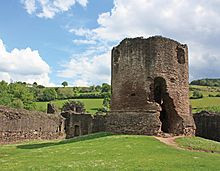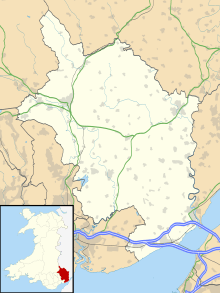Skenfrith Castle facts for kids
Quick facts for kids Skenfrith Castle |
|
|---|---|
| Skenfrith, Monmouthshire, Wales | |

The keep and castle interior
|
|
| Coordinates | 51°52′42″N 2°47′25″W / 51.8784°N 2.7902°W |
| Site information | |
| Owner | National Trust |
| Controlled by | Cadw |
| Open to the public |
Yes |
| Condition | Ruined |
| Site history | |
| Materials | Red sandstone |
| Events | Norman invasion of Wales |
|
Listed Building – Grade II
|
|
Skenfrith Castle (Welsh: Castell Ynysgynwraidd) is a ruined castle in the village of Skenfrith in Monmouthshire, Wales. This old fortress was first built by the Normans after they invaded England in 1066. Its main job was to protect an important route from Wales to Hereford.
Over time, Skenfrith Castle became part of a group called the "Three Castles" along with Grosmont and White Castle. These castles were very important for defending the area from attacks from Wales for hundreds of years.
Around the end of the 1100s, Skenfrith Castle was rebuilt using strong stone. Later, in 1201, King John gave the castle to a powerful official named Hubert de Burgh. Hubert completely rebuilt the castle, giving it a new rectangular shape with round towers and a circular keep in the middle.
By 1282, a new king, Edward I, had conquered Wales. This meant Skenfrith Castle was no longer needed for military defense. Over the centuries, it slowly fell into ruin. Today, the National Trust looks after the castle, and it is managed by Cadw, a Welsh heritage agency.
Contents
Skenfrith Castle: A Medieval Fortress
Building the Castle: Early Days
Skenfrith Castle was first built after the Normans invaded England in 1066. The Normans quickly moved into the Welsh borderlands, an area known as the Welsh Marches. William the Conqueror made William fitz Osbern the Earl of Hereford. Earl William then captured towns like Monmouth and Chepstow.
The Normans used castles a lot to control the Welsh people. Castles helped them set up new towns and show their power over the land. Skenfrith Castle was one of three castles built in the Monnow valley. They were probably built by Earl William to protect the route leading from Wales to Hereford. The very first castle here was made from earth and wood.
Changes Over Time
After Earl William's son rebelled in 1075, the land around the castle was split up. But in 1135, a big Welsh revolt happened. To respond, King Stephen brought Skenfrith Castle and its two sister castles, Grosmont and White Castle, back under the control of the king. They became known as the "Three Castles".
Fighting with the Welsh continued. In the 1170s, some powerful families attacked their Welsh rivals. This led to a Welsh attack on nearby Abergavenny Castle in 1182. Because of this, the king prepared Skenfrith Castle for battle. In 1186, money was spent to improve its defenses. More work was done in 1190, likely adding a stone keep and a strong curtain wall.
A Powerful Owner: Hubert de Burgh
In 1201, King John gave the Three Castles to Hubert de Burgh. Hubert was a royal official who became very powerful. He started to improve his new castles, beginning with Grosmont. But then he was captured while fighting in France.
While Hubert was a prisoner, King John took back the Three Castles. He gave them to William de Braose, who was a rival of Hubert's. King John later fell out with William. But William's son, also named William, took the castles back during a war called the First Barons' War.
When Hubert was released, he became powerful again. He got the Three Castles back in 1219, during the time of King Henry III. Hubert completely rebuilt Skenfrith Castle. He flattened the old castle and built a new rectangular one. It had round towers and a central circular keep.
Hubert lost power in 1232, and the castles were taken from him. They were given to a royal servant named Walerund Teutonicus. Walerund built a new chapel at the castle in 1244. He also fixed the keep's roof. In 1254, Skenfrith Castle and its sister castles were given to King Henry's oldest son, Prince Edward.
The Welsh threat continued. In 1262, the castle was prepared for an attack by Prince Llywelyn ap Gruffudd. The castle's commander was told to defend Skenfrith "by every man, and at whatever cost." Luckily, the attack never happened.
The Castle's Later Years
In 1267, Edmund, the Earl of Lancaster, was given the Three Castles. For many centuries, these castles were owned by the Earls, and later Dukes, of Lancaster. Not much more building work was done at Skenfrith.
When King Edward I conquered Wales in 1282, Skenfrith Castle was no longer needed for fighting. Even though it was still used as an administrative center, it slowly fell into disuse. By 1538, Skenfrith Castle was ruined. A description from 1613 said it was "ruynous and decayed."
In 1825, the Three Castles were sold to Henry Somerset, the Duke of Beaufort. Later, a lawyer named Harold Sands bought it. He did some work to preserve the site. He then gave the castle to the National Trust. Skenfrith Castle was put into the care of the state in 1936, and a lot of repair work was done. Today, Cadw manages Skenfrith Castle. It is protected by UK law as a grade II* listed building.
What You Can See Today
Skenfrith Castle was built next to the River Monnow. The castle you see today was built by Hubert de Burgh in the early 1200s. He leveled the older Norman castle and built a new one. The castle has a polygon shape, with four walls of different lengths. It was built from Old Red Sandstone.
Originally, a water-filled moat protected the castle. It was about 9 feet deep and 46 feet wide, fed by the river. Today, the moat is filled in and covered with grass. You would have entered the castle from the north-west side, over a bridge and through a gatehouse. These are now destroyed.
The outer curtain wall still stands up to about 5 meters (16 feet) high. It probably had a protective wooden structure on top. The castle had round towers at each corner for storage and defense. Three of these towers still stand. A small opening called a watergate on the eastern side led down to the Monnow River.
Inside the castle, there was a two-story hall building. Only its foundations remain today. This building had a long room and a smaller chamber. The floor of the hall was later raised because of flooding. The main hall would have been on the first floor. The south end of the building held a water reservoir for the castle. There was also a kitchen block, but nothing of it remains above ground.
The three-story circular keep is in the middle of the castle. It is about 12 meters (39 feet) high and 10 meters (33 feet) across. It has a staircase tower on one side. This keep is similar to others built in France and at Pembroke around the same time. Earth was piled up around the base of the keep, probably to protect its walls.
Originally, the keep would have had a wooden defense structure on top. A wooden staircase led up to the entrance on the first floor. The entrance you see at ground level today was cut into the walls later. The basement was used for storage. The first floor was an antechamber, and the second floor had windows, a large fireplace, and a private toilet. This was where the lord of the castle would have lived.



